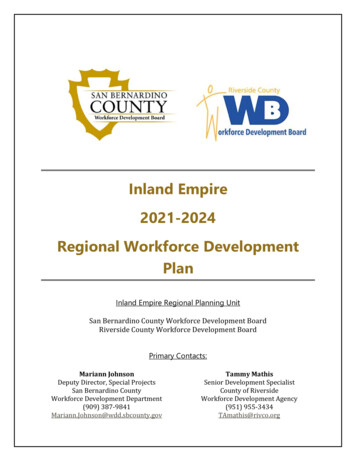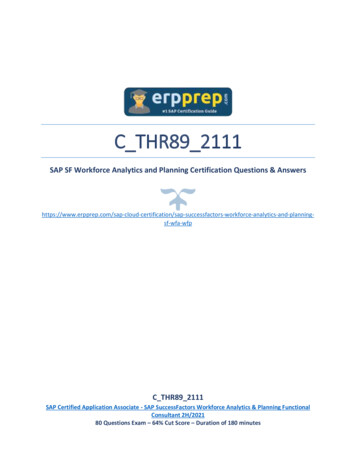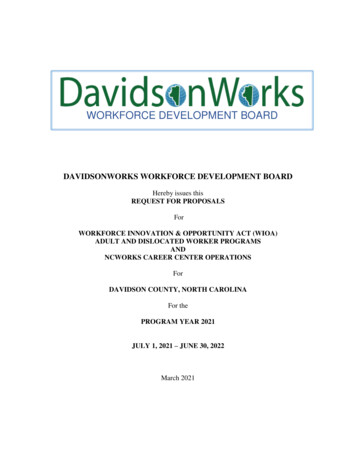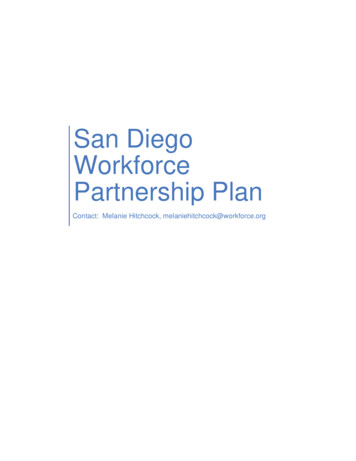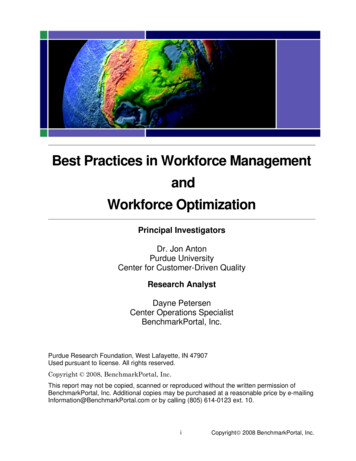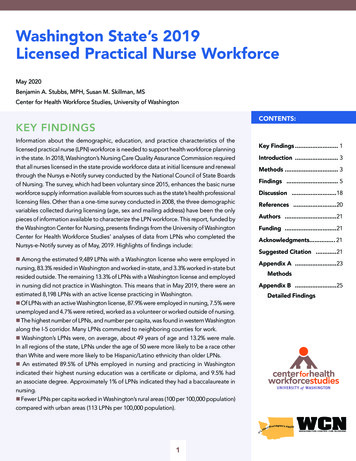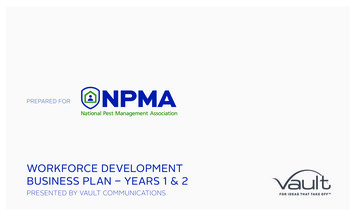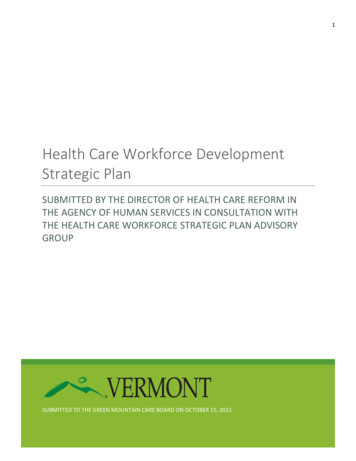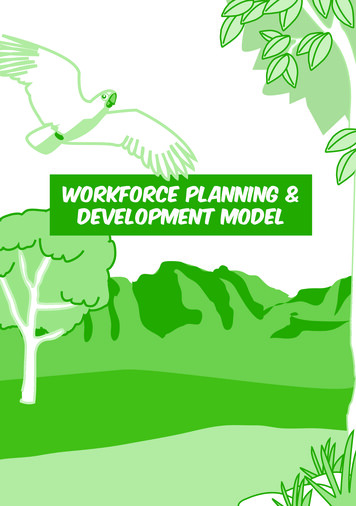
Transcription
Workforce Planning &Development Model
Overviewwhat is workforce planning?Workforce planning is an organised process for: Identifying the number of employees and the types of employee skill setsrequired to meet your organisation’s goals, strategic objectives and servicedelivery requirements. Developing a plan of action to ensure that the appropriate workforce will beavailable to provide quality services to the Community Sector clients in theNorthern Territory.why is it important?Within the next decade, the Community Sector in the NT can expect to see: A growing number of retirements from our predominantly mature workforce. Increased competition for highly skilled employees. An increasing demand for organisation services. Continuing financial challenges.To address these factors, organisations must take the time to develop usefulworkforce plans to ensure they have the right number of people in the right jobs atthe right time to meet their goals and objectives, and to plan for future growth.This Workforce Planning & Development Model is a reference for that purpose.It was designed to assist NT Community Sector organisations with theirworkforce planning processes and in developing their workforce plans. Theworkforce planning model and processes described in this guide are derived fromconsiderable research on workforce planning in other states and thorough reviewof available literature.Many industries and organisations have developed models for workforce planning.Except for variations in terminology and the order of the processes, most modelsare somewhat similar. The model documented in this guide has attempted to takeinto account the unique operating cultures and needs of the NT Non-GovernmentCommunity Sector. It is simple, flexible and can be modified to address yourorganisation’s specific and distinctive needs.
Workforce Planning &Development ModelPhase i - Getting StartedDetermine your workforce futurefunctional requirements using yourorganisation’s strategic planningand budgeting processes.Phase IV - Monitor,evaluate & revisePhase II - workforce analysis Assess what is working andwhat is not working Analyse supply: your currentworkforce profile Make adjustments to theworkforce plan Analyse demand: your futureworkforce profile Address new organisationalissues that affect the plan Analyse gap: identify discrepancybetween supply & demand Update the workforce plan andcommunicate the plan Develop strategy: recommendsolutions to reduce shortagesin staff and the skills required –document this plan.Phase iii - Implement plan Communicate the workforce plan Implement strategies to reducegaps and shortages
phase i - getting startedDetermining your organisation’s Strategic DirectionStrategic planning sets an organisation’s direction and defines its goals and measurableobjectives. These goals and objectives not only provide the basis for determiningnecessary financial resources, but they also provide the basis for determining workforceneeds.Workforce planning complements and is a follow-up to strategic planning. A workforceplan translates strategy into action to identify workforce staffing and training needs. Itattempts to answer the following questions: How many and what types of jobs and skills are needed to meet the mission andstrategic goals of the organisation? What strategies should the organisation use to hire, retain, or teach these skills?To understand your organisation’s direction and future workforce needs, a summary ofthe mission, strategies, and goals over the next five years will need to be documentedand analysed. Usually the most valuable workforce planning information can be foundin your organisation’s strategic plan and budget.Starting placeactions to considerStrategic Plan Document and/or analyse your organisation’s strategic plan. Identify mission, key strategies, goals and workforce issues. Determine whether there are pending changes to theorganisation’s mission that would affect your workforce now orin the future. Analyse your budgets and forecasts. Determine whether there will be budget issues affecting yourcurrent or future workforce.Budget InformationDecide ScopeDetermine whether your workforce plan will also cover your entireworkforce or a more limited scope, such as: Focusing only on occupations delivering key services. Focusing only on occupations that are difficult to recruit to orretain people in. Focusing on a particular stategy outlined in the strategic planto ensure that the right people are available to get the workdone.
phase ii - conducting yourworkforce analysesAnalysis of workforce data is the key element in the workforce planning process.Workforce analysis frequently considers information such as occupations, skills,experience, retirement eligibility, diversity, turnover rates, education, and trend data.There are four key steps to the workforce analysis phase of the planning model. Thesesteps are illustrated below.Step 1: analyse supplySupply analysis focuses on an organisation’s existing and future workforce supply. Itanswers the question, “What is the existing profile of the current workforce, and whatdoes it need to be in the future to accomplish our goals and objectives?” To assist withthis process refer to the Current Staff Profile Template (spreadsheet) and WorkforceProfile Template (spreadsheet) provided in the “Templates” folder on the WorkforceToolkit CD.Starting placeactions to considerDetermine Supply FactorsDetermine and document the workforce profile: Identify your employees’ ages, genders, ethnicity factors(if relevant), education levels and length of service. Determine the skill profile of your workforce. You may wantto compare the best, average, and poor performers. Whatknowledge, skills and abilities do high performers use toachieve success? Identify any workforce management issues that affect yourworkforce. Ask your frontline managers to identify segments of theworkforce that are currently or potentially vulnerable. Review retention, turnover, promotion patterns and leaveusage. Determine whether your organisation’s turnover rate affects itsability to deliver services. Review staff retirement plans and patterns. Project what the skill and experience level of the currentworkforce needs to be in the future. How have and will retirements affect your organisation andability to deliver service? What other challenges might affect the organisation’s ability torecruit and retain important skills?Step 2: analyse demandDemand analysis identifies the future workforce needed to carry out your organisation’smission. The focus of this step should be on the work the organisation must performand on the staff needed to perform that work. To assist with this process refer to thesimple Workforce Profile Template (spreadsheet) provided in the “Templates” folder onthe Workforce Toolkit CD.
Starting placeactions to considerExamine Internal/ExternalEnvironmental FactorsDemographic Identify significant external demographic issues that are likelyto influence the demands placed on the organisation, such asthe aging population.Technological Investigate how technology can and will be used to enhanceservice provision. Identify jobs that will be affected by technologicalenhancements. Determine whether any changes in technology will affect thenumber of employees needed to do the work or the type ofskills needed.Economic Are there funding and economic considerations that haveparticular relevance to the organisation and its provision ofprograms and services?Labour market Identify labour trends. Examine student information available from educationalinstitutions. Assess where you might get staff from both internally andexternally. Identify issues associated with the use of non-permanent staff,including cost and supply.Summary Will the way the work is being done need to change? Will programs/services be added or deleted? Will current employees have the necessary skills to do thework in the future? What types of employees/skills are needed for the future? Will the workload change? Will more or fewer employees be needed?Step 3: GAP AnalysisGap analysis involves comparing the workforce supply projection (Step 1) to theworkforce demand forecast (Step 2) and attempting to answer the following questions: What new skills will the organisation need to accomplish its goals and objectives? Does the organisation’s workforce currently have the anticipated needed skills? What job functions or skills will no longer be required?The organisation will establish workforce strategies based on the results of this analysis.Analysis results may show one of the following: A gap (when projected supply is less than forecast demand), which indicates afuture shortage of workers or skills. It is important to know what critical jobs willhave gaps so the necessary training or recruiting can be anticipated.
A surplus (when projected supply is greater than forecast demand), whichindicates a future excess in some categories of workers and may require action.The surplus data may represent occupations or skills that will not be needed inthe future or at least will not be needed to the same extent.Step 4: Strategy DevelopmentThe final step in Phase II, the workforce analysis phase, involves the developmentof strategies to address future gaps and surpluses. Strategies include the programs,policies, and practices that assist an organisation in recruiting, developing, andretaining the critical staff needed to achieve its mission and strategic goals.Strategies can fall into the broad categories of: Recruitment strategies to find and hire apprentices and trainees or qualifiedcandidates from the private sector. Check out the following topics in the Toolkit forsome additional suggestions: Topic 1 – How do you find the people you need? Topic 2 – Advertising your jobSelection strategies to help you find, recognise and select the best possiblecandidates in what is often a very competitive marketplace. Take a look at theseToolkit topics for some innovative and perhaps even radical ideas: Topic 3 – So, why don’t you tell me about yourself Topic 4 – Use simple, user-friendly recruitment processesRetention strategies to encourage employees to stay in the organisation. Someinitiatives to consider as well as a retention checklist and some stress–buster ideashave been provided: Topic 5 – Is it just about money? Topic 6 – Stress what can we do about it? Staff development strategies to build capacity by shaping and developing staffcapabilities and prepare employees for new roles or responsibilities. We havedeveloped some templates to help you document and manage this process. Referto the Individual Learning and Development Plan Template and Skills ProfileTemplate provided in the “Templates” folder on the Workforce Toolkit CD. Succession planning strategies to ensure that there are qualified people capable offilling critical positions, and knowledge transfer strategies to capture the knowledgeof experienced employees before they leave your organisation. Take a look at Topic7 – What if?.a quick and easy guide to Succession Planning in the Toolkit.Remember: Strategies should be kept to a manageable number so they can beachievable, and they should be prioritised to allow your organisation to focus itsresources on the most important strategies first.
phase iii - implementingyour workforce planAn organisation may need a separate action plan to address the implementationof each strategy in your workforce plan. Before implementing the plan, you shouldconsider:Strategies can fall into the broad categories of: Ensuring that there is executive and board support for the workforce strategies. Allocating necessary resources to carry out identified workforce strategies. Clarifying roles and responsibilities in implementing the strategies. Establishing timelines. Defining performance measures, milestones and expected deliverables. Communicating the plan.Remember: Your workforce plan should be implemented in connection with therequirements of organisation’s strategic plan. If the strategic plan changes due tounanticipated funding, leadership or even legislative changes then adjustments toworkforce plan strategies may be necessary.phase iV - Monitor,Evaluate and ReviseOngoing evaluation and adjustments are important in workforce planning and are key toproviding a usable process that works for the Community Sector.Workforce plans should be reviewed annually. If an organisation does not regularlyreview its workforce planning efforts, it risks failing to respond to unanticipated changesand challenges.Consequently, you should establish a process that allows for a regular review of yourworkforce planning efforts to: Review performance measurement information. Assess what is working and what is not working. Adjust the plan and strategies as necessary. Address new workforce and organisational issues that occur.Organisations should ask the following questions to determine whether the plan needsrevision: Have organisation strategies changed? Are the assumptions used in both the demand and supply models still valid? Have there been changes that would require a review of the strategies?
Useful DefinitionsWorkforce Planning:Workforce planning is looking at what an organisation needs to accomplish in agiven period of time; what knowledge, skills, and experience are required to getthe job done; and how large and what type of workforce is required to providethat mix of skills, knowledge, and experience. It defines the activities necessaryto have “the right people with the right skills in the right place at the right time”.Functional Requirements:Are the key functions that need to be performed in order to accomplish thedirection set out in the Strategic Plan. Remember: functional requirements focuson the job function not on the people needed to do the job.Strategic Planning:Is an organisation’s process of defining its strategy, or direction, and makingdecisions on allocating its resources to pursue this strategy.Workforce Profile:Is a collection of confidential data about your employees. It can include age,gender, employment status (permanent part-time, casual), tenure, remunerationand qualifications.Frontline Management:Is the first level of management, that is, the level of management that overseesor manages the actual doing of work.Gap analysis:The difference between what is needed and what is available. It also representsthe difference between where you are and where you want to be.Succession Planning:A process designed to ensure the continued effective performance of anorganisation by making provision for the development and replacement of keypeople over time. Succession planning is generally considered to be a strategyof workforce planning.Performance measures:Common measures for evaluating performance include outputs, outcomes, andefficiency. Performance Measures answer the question, ‘How is the organisationdoing at the job of meeting its strategic objectives?Milestone:Is a key achievement at a specific stage in a project. A milestone is typically animportant project event, such as the achievement of a key deliverable.Deliverable:Measurable outputs, services, items or change produced by a givenproject or activity.
Workforce Planning Templates- Quick Help GuideThis guide is designed to assist in the completion of the workforce planning templates.You can find the templates in the “Templates” folder on the Workforce Toolkit CD.The following provides a brief description of each of the templates with instructions onhow to complete them:Users:Enter Full Time Equivalent (FTE)e.g. 4 days per week 0.8 FTEYear 3Users:Enter the number of FTE foreach position in the year youanticipate you will require thestaffYear 2Year 1Year 4Year 3Year 2ActualFTEsYear 1The template is based on a singlespreadsheet that requires you to enterthe following information:CasualWorkforce Profile (spreadsheet)This template provides you with the ability to analyse your current workforce profile(Supply Analysis), future staff requirements (Demand Analysis) and the resultingGap Analysis to give you informationWORKFORCE PROFILE TEMPLATEENTER ORGANISATION NAMEregarding current and future workforcePlanned FTEGAPEmployment Statusrequirements.Temporary Part-timeCurrent Staff Profile (spreadsheet)This template provides you with the ability to document your current staff profile.A sample spreadsheet with sample data is provided for your guidance.Permanent Existing Workforce. Enter a separateline for each position type within each location. Future Workforce. This is based on your future staff requirements to meetchanging business needs and requires you to enter the total number of staff youwill require in each position/location in the year in which you will require them.Comments to provide assistance are included in the spreadsheet. These can beaccessed by moving your mouse over the red triangle at the top of each columnThe spreadsheet will then automatically calculate a Gap Analysis that shows inwhich year you need to increase or decrease staff. An example spreadsheet withsample data is provided for your guidance. Skills ProfileThis template details the required skills to perform specific job roles within yourorganisation. Each job classification within your organisation should have anappropriate skills profile. An example Skills Profile with sample data is provided foryour guidance. Individual Learning & Development PlanThis template allows you to build and record development plans for each individualwithin your workforce. It also provides the ability to track progress against the plan.An example Individual Learning & Development Plan with sample data is providedfor your guidance.
Employee NameClassification Levels1 critical role3 required role5 optional roleStaffIDDate of BirthM/FFirst StartDateJob t StatusPart TimeCURRENT STAFF PROFILE TEMPLATEENTER ORGANISATION NAMEFTEHighest Level of Qualification AttainedReport dated 2/09/08– Current Staff ProfileTemporaryWorkforce Planning TemplateCasual
Classification Levels1 critical role3 required role5 optional roleJob TitleTotalLocationActualFTEsGAPYear 2Year 3Year 2Year velWORKFORCE PROFILE TEMPLATEENTER ORGANISATION NAMEPlanned FTEEmployment StatusYear 1Year 4Highest Level of Qualification RequiredReport dated 2/09/08– Workforce ProfileYear 3Workforce Planning TemplateYear 4
Skills Profile TemplateJob TitleCore organisational competenciesWhat will be the core competencies requiredfor our organisation?Job family competenciesWhat will be the common competenciesrequired for this function, team or job type?Job specific competenciesWhat will be the specific competenciesrequired for this job role?
Individual Learning and Development Plan TemplateName:Date:Job role:Department/team:Line Manager:Process: Identify assessment method (self, evidence based, line manager verification)of individual against the skills profile for the job role, linked to performance managementcycle.StrengthsLearning needsDevelopment required (priority)Continuous improvement areas
NT Council of Social ServicePO Box 1128 Nightcliff NT 0814www.ntcoss.org.auadmin@ntcoss.org.auThe Australian Government has contributed to funding this Programme under theCouncil of Australian Governments Skills Package – Regional Initiatives (Targeting Skills Needs in Regions Programme).
phase ii - conducting your workforce analyses Analysis of workforce data is the key element in the workforce planning process. Workforce analysis frequently considers information such as occupations, skills,
